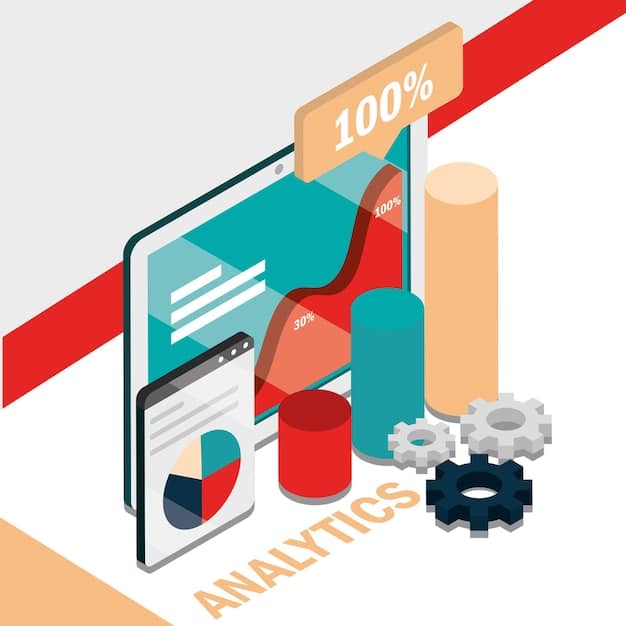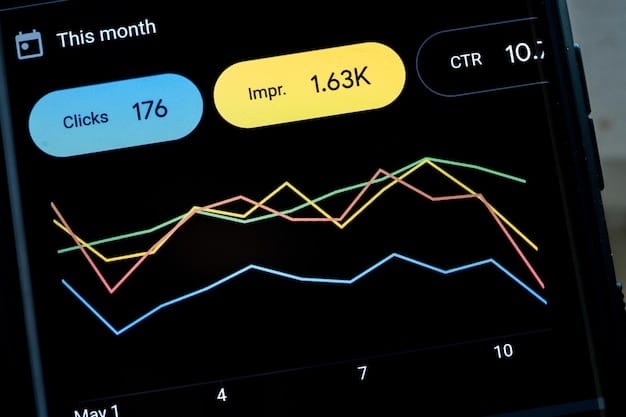Data-Driven Content Marketing: Boost Traffic by 40% with Analytics

Data-Driven Content Marketing leverages analytics to understand audience behavior, optimize content strategy, and ultimately increase website traffic, with potential gains of up to 40%.
Unlock the power of data to transform your content strategy. Data-Driven Content Marketing: Using Analytics to Increase Website Traffic by 40% isn’t just a buzzword; it’s a proven methodology to attract, engage, and convert your target audience through informed decision-making.
What is Data-Driven Content Marketing?
Data-driven content marketing is the strategic process of creating, distributing, and optimizing content based on insights gleaned from data analytics. It involves understanding your audience, their preferences, and behaviors to tailor content that resonates and drives results.
The Core Principles
At its core, data-driven content marketing prioritizes evidence over intuition. This means every content decision, from topic selection to format choice, is guided by empirical data. By analyzing metrics such as website traffic, engagement rates, and conversion data, marketers can gain a deeper understanding of what works and what doesn’t.
- Audience Understanding: Data helps identify your ideal customer, their needs, and their preferred content formats.
- Performance Measurement: Analytics track the effectiveness of your content efforts, revealing which strategies deliver the best results.
- Continuous Improvement: Data insights fuel ongoing optimization, refining your content to maximize its impact.
Furthermore, this approach demands a shift from traditional content creation relying heavily on guesswork to a more scientific methodology. It necessitates the integration of various data sources, from website analytics to social media insights, enabling a holistic view of content performance.
In conclusion, data-driven content marketing empowers businesses to create content that is not only engaging but also strategically aligned with their objectives, leading to higher ROI and sustainable growth.
Why is Data-Driven Content Marketing Important?
In today’s crowded digital landscape, simply creating content is not enough. Data-driven content marketing offers a competitive edge by ensuring your content is relevant, engaging, and effective.

Increased ROI
By focusing on data, you can eliminate wasted effort and resources. Data-driven insights help you invest in content that is more likely to generate leads, drive sales, and build brand loyalty. Understanding campaign effectiveness is key to demonstrating the value of marketing initiatives and securing future budgets. Data-driven content marketing allows for precise tracking and measurement, providing a clear view of ROI.
Improved Audience Engagement
Data provides a window into your audience’s preferences, allowing you to create content that addresses their specific needs and interests. This leads to higher engagement rates, more shares, and stronger relationships. Content that resonates fosters a sense of community, thereby improving brand loyalty and advocacy.
Data-driven content marketing allows you to personalize content, catering to different segments of your audience. This customization can significantly increase engagement rates as individuals receive information tailored to their unique interests.
- Better targeting
- Personalized content
- Increased relevancy
In conclusion, data-driven content marketing ensures efforts are targeted, efficient, and impactful, leading to sustainable growth and improved customer relationships.
Key Metrics to Track in Content Marketing
To effectively implement a data-driven content marketing strategy, you need to identify the key metrics that align with your goals. These metrics provide valuable insights into content performance and audience behavior.
Website Traffic
Monitoring website traffic is crucial for understanding how your content attracts visitors. Tools like Google Analytics provide insights into traffic sources, page views, and bounce rates. Analyzing traffic patterns reveals what content is resonating with the audience, guiding future creation efforts. Understanding visitor behavior can help optimize the user experience, thereby increasing engagement and conversion rates.
Engagement Metrics
Engagement metrics measure how users interact with your content. This includes metrics such as time on page, social shares, comments, and click-through rates. Higher engagement indicates that your content is captivating and valuable to your audience. Analyzing engagement data provides clues on content preferences allowing for adjustments to style, format, and messaging.
Analyzing qualitative feedback, such as comments and reviews, offers additional insights into audience sentiment and specific areas of interest.

Conversion Rates
Conversion rates track the percentage of users who take a desired action, such as signing up for a newsletter or making a purchase. Monitoring conversion rates helps assess the effectiveness of your content in driving business outcomes. Optimizing content for conversions may involve refining calls-to-action, landing page design, and overall user experience.
- Identify key performance indicators (KPIs) aligned with your goals.
- Track metrics such as website traffic, engagement, and conversion rates.
- Use data insights to optimize content strategy and improve ROI.
In conclusion, key metrics provide a comprehensive view of content performance, enabling marketers to make informed decisions and drive continuous improvement.
Tools for Data-Driven Content Marketing
Several tools can help gather, analyze, and interpret data for your content marketing efforts. These tools range from website analytics platforms to social media listening tools.
Google Analytics
Google Analytics is a comprehensive web analytics platform that provides detailed insights into website traffic, user behavior, and conversion rates. It allows you to track various metrics, create custom reports, and analyze data to optimize your content strategy. The ability to segment data by demographics, interests, and behavior adds depth to audience understanding and personalization efforts.
SEMrush
SEMrush is a versatile tool that helps with keyword research, competitive analysis, and content optimization. It provides insights into search engine rankings, backlink analysis, and competitor content strategies. This tool enables marketers to identify high-performing keywords and content ideas, thereby increasing organic search visibility.
Using SEMrush, businesses can also identify and track trending topics, ensuring their content remains relevant and timely. This capability is particularly valuable for attracting new audiences and engaging existing ones.
- Tools like Google Analytics and SEMrush help collect and analyze data.
- These tools provide insights into website traffic, engagement, and keyword performance.
- Utilize data to identify content opportunities and optimize strategy.
Social Media Analytics Tools
Platforms like Hootsuite or Buffer provide social media analytics, allowing you to track engagement metrics, audience demographics, and content performance across various social channels. Understanding social media data helps inform content strategy and optimize posting schedules. These tools also enable marketers to monitor brand mentions, assess sentiment, and engage with their audience more effectively.
In conclusion, utilizing the right tools can streamline data gathering, analysis and interpretation, empowering markets with actionable insights to optimize their content strategies effectively.
Creating a Data-Driven Content Strategy Step-by-Step
Creating a data-driven content strategy involves a systematic approach that prioritizes data insights at every stage. This ensures that your content is aligned with audience needs and business goals.
Step 1: Define Your Goals
Start by defining your content marketing goals. Are you aiming to increase website traffic, generate leads, or build brand awareness? Clearly defined objectives will guide your data collection and analysis efforts. Aligning content goals with overall business objectives ensures efforts contribute to organizational success. Specific, measurable, achievable, relevant, and time-bound (SMART) goals are highly recommended.
Step 2: Gather Data
Collect data from various sources, including website analytics, social media insights, customer surveys, and sales data. The more comprehensive your data, the more accurate your insights will be. Ensure data privacy and compliance with regulations such as GDPR and CCPA. Data quality is paramount; inaccurate or incomplete data can lead to flawed insights and ineffective strategies.
Data should also be regularly updated to reflect changing trends and customer behaviors.
- Define clear content marketing goals (e.g., increase traffic, generate leads).
- Gather data from website analytics, social media, and customer surveys.
- Analyze data to identify content opportunities and audience preferences.
Step 3: Analyze the Data
Analyze the data to uncover patterns, trends, and insights. Identify what content resonates with your audience, which channels perform best, and what topics generate the most engagement. Use data visualization tools to present insights in a clear and understandable format. Involve cross-functional teams in data analysis to gain diverse perspectives and insights.
In conclusion, creating a data-driven content strategy requires clearly defined goals, comprehensive data, meticulous analysis, and continuous optimization.
Measuring the Success of Your Data-Driven Content
Measuring the success of data-driven content is essential to determine if you are achieving goals and optimizing strategy.
Regular Reporting
Establish a regular reporting schedule to track progress and identify areas for improvement. Share reports with stakeholders to keep everyone informed and aligned. Use data dashboards to visualize key metrics and track performance trends over time. Regular reporting enables timely adjustments and keeps the strategy aligned with evolving business objectives.
A/B Testing
A/B testing involves comparing different versions of content to see which performs better. This can include testing different headlines, images, or calls-to-action. A/B testing provides empirical evidence about what resonates with the audience, allowing for continuous optimization. Ensure A/B tests are conducted with statistical rigor to validate results and avoid false positives.
A/B testing should not be limited to content elements but extended to channels, formats, and timing.
- Establish regular reporting to track progress and identify areas for improvement.
- Use A/B testing to optimize content elements and improve performance.
- Continuously monitor and adjust strategy based on data insights.
Iterate and Optimize
Based on your data insights, iterate and optimize your content strategy. This may involve adjusting your content topics, formats, or distribution channels. Continuous optimization is crucial for maximizing the impact of your content. Regularly re-evaluate the strategy in light of changing market conditions and competitive landscape.
In conclusion, consistently measuring success, employing A/B testing, and optimizing based on data are critical for data-driven optimization.
| Key Point | Brief Description |
|---|---|
| 🎯 Define Goals | Set clear, measurable objectives for your content marketing efforts. |
| 📊 Gather Data | Collect data from various sources like website analytics and social media. |
| 📈 Analyze Data | Uncover trends and insights to understand what resonates with your audience. |
| 🔄 Optimize Strategy | Continuously improve your content based on A/B testing and performance metrics. |
Data-Driven Content Marketing
It’s creating and optimizing content based on data insights to better reach and engage your target audience, leading to increased website traffic and conversions.
Data helps you understand audience preferences, measure content effectiveness, and optimize strategies for better ROI and improved customer relationships over time.
Track website traffic, engagement metrics (time on page, shares), and conversion rates to gauge content performance and identify areas for improvement on the web.
Google Analytics, SEMrush, and social media analytics tools provide valuable data on website performance, keyword research, and audience engagement across platforms.
Define goals, gather data, analyze insights, and iterate based on data-driven findings to ensure content meets audience needs and drives business results across platforms.
Conclusion
In conclusion, data-driven content marketing empowers businesses to create relevant, engaging, and effective content that resonates with the target audience, drives website traffic, and generates significant ROI. By leveraging data insights, marketers can continuously optimize their strategies and achieve sustainable growth, and improve overall marketing success.





